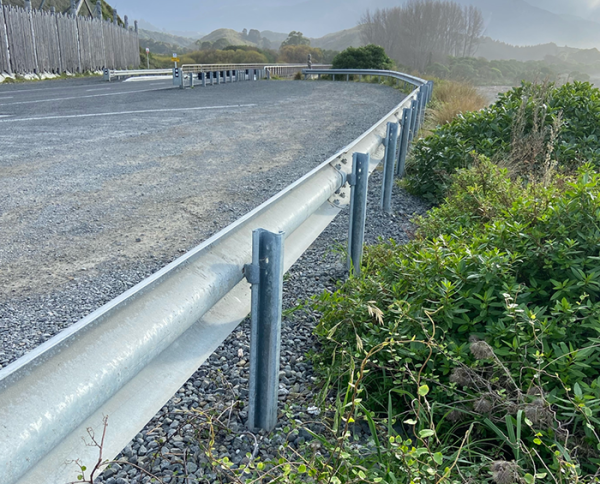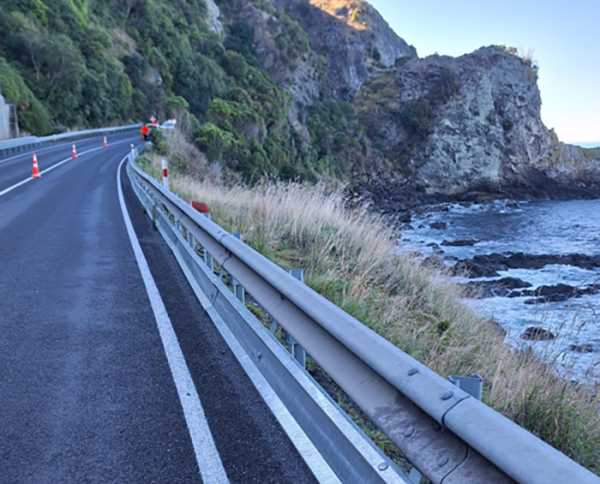A stretch of coastline at Kaikōura has become a safer place for both fur seal pups and road users after a joint effort by NZ Transport Agency Waka Kotahi (NZTA), Department Of Conservation/Te Papa Atawhai (DOC) and Te Kunenga ki Pūrehuroa Massey University.
A lower band of protective guardrail has been added to existing guardrail at eight sites along the coastline in recent weeks. The sites were among those identified as being high risk for fur seal pups getting onto SH1 in a study published by Massey University PhD student Alasdair Hall.
The NZTA team, led by Jessica Swift and supported by Carol Bannock, were keen to do what they could to manage the risk to road users and fur seals by safely separating seals from the highway and fast-moving traffic.
By combining DOC’s findings on where fur seals were most likely to be hit by vehicles on SH1 and NZTA’s ongoing highway maintenance programme, eight stretches of coast were identified where a lower-level guardrail could be retrofitted to existing higher rails. This would stop seals getting onto the road.
The lower-level guardrail is used in many other places on New Zealand highways primarily to protect motorcyclists from sliding under the guardrail in the event of a crash or getting trapped in the guardrail fence. This type of protective railing also increases safety for all road users not just motorcyclists.
The aim was to get the additional guardrail installed in time for the late autumn/winter period when pups are most likely to be killed on the road. Teams from DOC and NZTA worked closely together to confirm site locations, length of guardrail needed (1.2km) then get a fencing contractor and the work underway.
By early May, the additional, lower guardrail had been installed at all eight sites. (See photos below).
During a site visit by DOC and the NZTA project team during the installation of the lower-level guardrails, seven dead pups were counted in two small stretches of the road. Had the guardrail been in place a week earlier, they would likely not have made it onto the road and been killed. While upsetting to see, this demonstrated what this work is for, and why it’s so important.
DOC and NZTA are confident that the fencing will see a notable decrease in the number of fur seal incidents on SH1 in the future, and an added layer of protection for motorcyclists and all road users on this spectacular stretch of SH1.
In the aftermath of the 2016 Kaikōura earthquake, NZTA and the partners repairing SH1 and the rail line learnt a lot about the natural environment - in particular the fur seal or kekeno.
Ryan Sutherland, who works for NZTA, was involved as an environmental advisor on the Kaikōura Earthquake Recovery project, repairing SH1 and the rail line in the aftermath of the earthquake. This included helping to shift fur seals out of harm’s way from big, mobile machinery. This year, Ryan was again able to help fur seals.
Joint investigations by Massey University Veterinary Professor Wendi Roe, working with Biosecurity New Zealand investigators and DOC into the deaths of more than 1,000 fur seal pups last spring along the Kaikōura coast, found that starvation was why these animals had died.
To learn more, DOC organised an urgent assessment and Ryan was involved in recording data, capturing, measuring and weighing pups.
‘It was certainly exhausting and smelly work, but I feel privileged to have helped, and as everyone who looks into the eyes of a pup would agree, absolutely worth it,” says Ryan.
The field team was led by Dr Jody Weir, a Marine Science Advisor for DOC who has worked with Kaikōura wildlife for the past 20 years. With 21 volunteers over three weeks in February this year, she concluded that the Ōhau colony had fewer than half the pups produced than in the previous year.
“It’s difficult to unravel the causes of starvation, but essentially the fur seals aren’t finding enough food to produce and then sustain pups. This is likely due to a combination of factors, including the changing climate and increases in sea surface temperature, not things we can solve quickly,” says Jody.
“On the other hand, we knew that there was something that could be done, with NZTA’s help, to significantly reduce the number of fur seal pups killed on this stretch of SH1, by boosting the guardrail protection in these key spots along SH1.”
On average 49 seals and pups are hit by vehicles and die on SH1 near the Kaikōura fur seal colonies each year.

Before

After
Kaikoura Earthquake Response (work done to rebuild SH1 and the rail line around the Kaikōura coast)
Research done on post-earthquake construction in Kaikōura and its impacts on fur seals helped the team work out where to focus efforts.
Post-earthquake highway reconstruction: Impacts and mitigation opportunities for New Zealand pinniped population(external link) - sciencedirect.com
Another study by Massey University and DOC found that pup numbers in the Ōhau Point colony in 2022/23 were similar to pre-quake numbers.
Massey University and DOC study on pup numbers(external link)
TVNZ story on the fur seal deaths along the Kaikōura coast (April 2024)(external link)